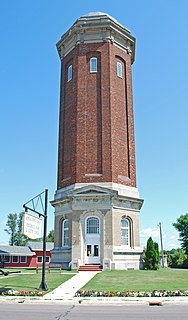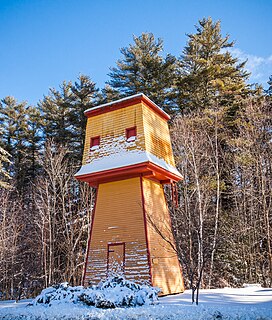
A water tower is an elevated structure supporting a water tank constructed at a height sufficient to pressurize a water supply system for the distribution of potable water, and to provide emergency storage for fire protection. In some places, the term standpipe is used interchangeably to refer to a water tower. Water towers often operate in conjunction with underground or surface service reservoirs, which store treated water close to where it will be used. Other types of water towers may only store raw (non-potable) water for fire protection or industrial purposes, and may not necessarily be connected to a public water supply.

The Beloit water tower is a historic 1889 octagonal limestone water tower in Beloit, Wisconsin.

The Lena Water Tower is a water tower located in the village of Lena, Illinois, United States. It was built in 1896 following two decades of problems with structure fires in the village. The current water tower is the result of a second attempt after the first structure proved to be unstable. The tower stands 122.5 feet (37.3 m) tall and is built of limestone and red brick. The current stainless steel water tank holds 50,000 gallons and replaced the original wooden tank in 1984. The site has two other structures, an old power plant building and a 100,000 US gallon reservoir. The Lena Electric Plant Building was constructed in 1905 and the reservoir completed in 1907. The Lena Water Tower was listed on the U.S. National Register of Historic Places in 1997; the reservoir was included as a contributing property to the listing.

The U-Drop Inn, also known as Tower Station and U-Drop Inn and Tower Café, was built in 1936 in Shamrock, Texas along the historic Route 66 highway. Inspired by the image of a nail stuck in soil, the building was designed by J. C. Berry. An unusual example of art deco architecture applied to a gas station and restaurant, the building features two flared towers with geometric detailing, curvilinear massing, glazed ceramic tile walls, and neon light accents. It has traditionally held two separate business: "Tower Station", a gas station on the western side, and the "U-Drop Inn", a café on the eastern side. Though it has passed hands several times in its history, the building has consistently housed the same types of businesses it was originally constructed for.

Lawson Tower is a historic tower built in the style of a European castle turret. It is located off First Parish Road in Scituate Center, Massachusetts, United States. Built in 1902 to enclose a steel water tank, it is a major local landmark. The Scituate Water Company stopped using the tank in 1988. The tower is listed as both an American Water Landmark and in the National Register of Historic Places. It has become a popular tourist site, featuring sweeping views of the South Shore, Old Scituate Light, Minot's Ledge Light and the nearby First Trinitarian Congregational Church.

The Hackensack Water Company Complex is a set of historic buildings in Weehawken, New Jersey, registered in the U.S. National Register of Historic Places. The Hackensack Water Company, a predecessor of Suez North America, developed water supply and storage in northeastern New Jersey from the 1870s to the 1970s, initially to provide service to the city of Hackensack and the towns of North Hudson. Originally its headquarters and major facilities were located at Hackensack, in Bergen County. Under Robert W. de Forest, who ran the Hackensack Water Company for 46 years beginning in 1881, the company constructed new facilities and moved its headquarters to Weehawken in Hudson County, setting up offices in a brick water tower, part of the present complex.

Walka Water Works is a heritage-listed 19th-century pumping station at 55 Scobies Lane, Oakhampton Heights, City of Maitland, New South Wales, Australia. Originally built in 1887 to supply water to Newcastle and the lower Hunter Valley, it has since been restored and preserved and is part of Maitland City Council's Walka Recreation and Wildlife Reserve. It was added to the New South Wales State Heritage Register on 2 April 1999.

The Water Tower was built in 1897 by Challenge Wind and Feed mill Company of Batavia, Illinois. This is a rare wooden tank atop a brick tower type of water tower. Built on a limestone foundation, it is 140 feet (43 m) tall and about 20 feet (6.1 m) in diameter. The brick walls are 2 feet (0.61 m) thick.

Grindel Point Light is a lighthouse in Islesboro, Maine, marking the west entrance to Gilkey Harbor at the westernmost point of the eponymous island. The light station was established in 1850, and the present tower and keeper's house were built in 1874. The station was deactivated in 1934 and reactivated in 1987. It was listed on the National Register of Historic Places in 1987. The keeper's house now houses the Grindel Point Sailor's Museum and the lighthouse tower is open for tours in the summer.

Little River Light is a lighthouse on an island at the mouth of the Little River, in Cutler, Maine. A light station was first established at this site in 1846, and the present structure was built in 1876. It is one of the only iron lighthouses in the state, and was listed on the National Register of Historic Places as Little River Light Station on March 14, 1988. The light station is now owned by the American Lighthouse Foundation, which offers overnight stays in the keeper's house, and occasional tours of the property.

The Manistique Pumping Station is an industrial waterworks building located on Deer Street in Manistique, Michigan. It was listed on the National Register of Historic Places in 1981.

The Beaumont St. Louis and San Francisco Railroad Water Tank is a railroad water tank constructed in 1875, in Beaumont, Kansas. It served the St. Louis, Wichita & Western Railway, and was used to refill the boilers of steam locomotives on that line. It was added to the National Register of Historic Places in 1993.

The Benton Stone Water Tower is located in Benton, Wisconsin. It was added to the National Register of Historic Places in 1999.

The Fort Atkinson Water Tower is an unused water tower that was built in 1901 in Ft. Atkinson, Wisconsin. It was added to the National Register of Historic Places on November 15, 2005.

The Monroe Water Tower is a historic water tower built in 1889 in Monroe, Wisconsin. It was added to the National Register of Historic Places in 2005.

Grand Mound Town Hall and Waterworks Historic District, also known as Hose house, pump house, is a historic district located in Grand Mound, Iowa, United States. It was listed on the National Register of Historic Places in 2001. The district is composed of two buildings and the town's water tower.

The Cathance Water Tower is a historic water tower at Cathance Road and Beechwood Drive in Topsham, Maine. Probably built in the late 19th century, it is an extremely rare surviving example of a residential wooden water tower built for a single residence. It was listed on the National Register of Historic Places in 2001. It is now owned by the town.

The Manning Water Tower is a historic structure located in Manning, Iowa, United States. It is significant as a good example of early 20th-century steel elevated water tower design, and its association with Anson Marston and the Chicago Bridge & Iron Company. Marston, who designed the structure, was a professor of engineering at Iowa State College. Manning native Henry J. Brunnier, who studied under Marston, convinced the city council to use one of Marston's designs rather than a less expensive standpipe. He also assisted with this water tower's design, and went on to career as a civil engineer in San Francisco. Also involved in the tower's design was the Chicago Bridge & Iron Company, who built it in 1903. It replaced a pump house with a steam-powered engine and a large water tank that was built near the town's well in 1894. The water tower is 140.75 feet (42.90 m) tall. It has a 60,000-US-gallon (230 kl) steel tank, with a cast-iron center pipe, and four steel legs. The superstructure rests on concrete piers with limestone capstones, and the tank is capped with a pagoda-shaped roof. The water tower was listed on the National Register of Historic Places in 2016.

The South Main Street Historic District is a surviving collection of eleven commercial buildings built from 1877 to 1915 in the old downtown of Oregon, Wisconsin, plus the WWI memorial. It was added to the State and the National Register of Historic Places in 2000.




















